Cuba Leads Effort at Haiti Hospital
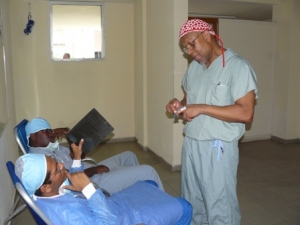
HAVANA TIMES, May 8 — Cuban doctors, a host of young physicians who studied medicine at the Havana based Latin American School of Medicine, and other volunteers MDs continue to offer treatment to Haitians victims of the January 12 earthquake. Conner Gorry for Mediccglobal brings us an on-the-scene report on their efforts at one of several facilities staffed by Cubans in Port-au-Prince.
MAKING THE ROUNDS: Hôpital Universitaire de la Paix
By Conner Gorry in Haiti
It’s not even 7:30 and already it’s hot as we board the bus for the circuitous, rubble-pocked ride to Hôpital Universitaire de la Paix. As the crow flies, it’s probably less than a mile from our tent camp to Port-au-Prince’s university teaching hospital, but weaving between vendors and tents pitched in the street, and then caught behind a tractor or backhoe, means it takes almost an hour to get to the front gate.
I’m traveling with the Cuban medical team that will staff the ER for the next 24 hours, relieving other members of the Henry Reeve Contingent. My fellow passengers include nurses, lab technicians, family physicians and a few other specialists, like Dr Douglas
Valverde, an energetic orthopedic surgical resident who received his training at Cuba’s Latin American Medical School (ELAM). Costa Rican by birth, Dr Valverde is one of the more than 700 ELAM-trained health professionals making up the Cuban-led international team.
Haitians of all ages are waiting their turn at medical tents pitched in the courtyard when we arrive. Things are fairly well organized, which is a dramatic improvement over the situation in the days following January 12. Hôpital Universitaire de la Paix was at or near capacity when the earthquake struck; it was quickly overwhelmed as the tremors subsided and new patients made their way in droves to the facility.
“The courtyard was filled with wounded people. To cross it we had to step over and around them saying ‘excuse me, excuse me, excuse me’ the whole time,” Dr Wilsos Canton, a Haitian graduate of the ELAM told me. “The building was in decent condition, but there was no light and no water. We delivered babies using the lights on our cell phones. There were patients everywhere,” he tells me in that stoic, but compassionate way Haitians have. This image of the aftermath settles over our conversation.
In the Post Op, Post-Quake
I’m sure what I’ll see today at Hôpital de la Paix won’t compare to those first days and even weeks after the earthquake. Still, coming into the post operative ward where orthopedic resident Dr Valverde and Cuban colleagues Dr Mariela Rodríguez and Dr Rafael Roque visit with patients, I’m rocked back on my heels.
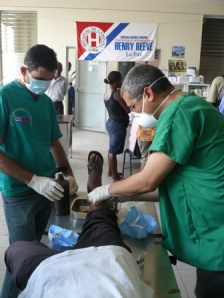
The heat in the 14-bed unit hovers over amputees of all ages, some moaning in what I imagine is pain mixed with frustration (and undoubtedly fear). This guttural chorus is joined by a clutch of women in the center of the room chanting and undulating, lost in energetic prayer. Daughters, girlfriends, nephews and neighbors wave kerchiefs and swaths of cardboard over their loved ones to keep the flies away. A piercing odor of human waste permeates the scene as an older woman, both legs cut off at the knee, talks to herself in a loud, stricken voice.
The first bed is occupied by one of Dr Valverde’s patients: a beautiful 18-year old who was hit by a car several days ago and presented with a broken femur. Although some of the 84 members of the Henry Reeve team working at this hospital speak Creole, Dr Valverde enlists translating help from one of the women who comes to pray for patients in this hospital several times a week. “She’s in pain and wants to know when you’ll operate,” the woman translates for us. Dr Valverde explains that they can’t operate until her femur is correctly re-aligned, something that without the proper traction equipment, will take a week—or more. The girl lets out a loud wail when this news is translated. Dr Valverde looks at me with wrinkled brow: “We rigged up this manual weight with a cinder block to help the healing process, but she’s obviously in a lot of pain.” He shifts her body a bit and adjusts the height of the block, asking via the translator if that felt better. It did.
We pass along the other beds, occupied by soft-eyed gentlemen
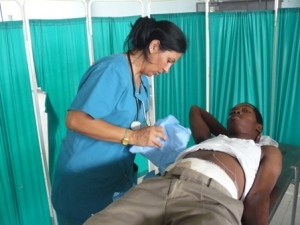
paralyzed the instant their houses fell on them in the quake, and young laborers hit by trucks in the disorder that has gripped the Haitian capital since January 12. Trailing behind the trio of surgeons, I learn about complications seen in their daily work here, including infections, phantom limbs (patients feeling pain in their amputated limbs) and depression. Shortages of even basic supplies, despite international donations that continue to roll in, are also a challenge.
A Haitian surgeon and nurse team consults with Dr Rodríguez about another case. Once they’re out of ear shot, I ask about her experience as a female surgeon in this very masculine of settings. She tells me about her two years working in Cap-Haïtien in Cuba’s Comprehensive Health Program—the international program which has bolstered public health systems around the world since 1998, including Haiti’s.
“The hospital I worked in was founded in 1812. In nearly 200 years, I was the first female surgeon they’d ever had,” she explains to me in the laidback manner common to Cubans from the eastern provinces. “It wasn’t a problem that I was a woman, but I had to prove myself in the operating room. Once I did, we got busy.”
Emergency Room Snapshot
With the morning hours dwindling, Rodríguez, Roque, and Valverde shift their attention from the post-op recovery rooms to the hospital’s emergency area. They join colleagues from Nicaragua, Panama, and Cuba’s Villa Clara and Pinar del Río provinces, (all Henry Reeve members), to attend arrivals in the partially screened area with four metal beds. Haitian nurses and medical students lend a hand translating, among their other duties.
There is a steady stream of patients. As in most emergency rooms, (especially post-disaster in the Global South), most patients are extremely sick, including some who won’t see tomorrow. This is the prognosis for the emaciated anemic grandfather and the young woman in a pretty pink dress who has had a high fever for two weeks. Malaria will soon consume her. It’s not only the severity of the conditions these doctors see day after day that is disconcerting; it’s that many of them are preventable. That anguish is written on Dr Adac Mendoza’s face, the ELAM doctor attending the young woman.
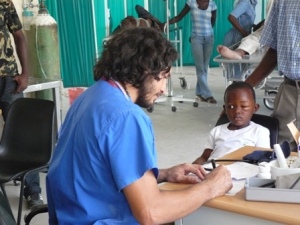
Accident victims and chronic disease are common in this ER, and between stitching a child’s split chin and taking the blood pressure of Haitian matrons, the doctors treat the aftershocks of natural disaster. A barefoot young boy hops over to the doctors with a badly infected wound on his left calf. Tears stream down his face as the gash is cleaned of dirt, stones, unidentifiable objects (glass? bread crusts? I can’t tell and neither can the attending physician), and finally necrotic tissue. He’s given a shot of antibiotics and told to come back in the evening for another injection, though the doctors admit they probably won’t see him again: transport is too scarce and life too precarious here in post-quake Haiti for many patients to pursue follow-up. Just then, an 18-year old girl staggers in and collapses on one of the metal beds. “She tried to poison herself,” her escort tells me in English. When I ask why, his response is as disturbing as it is vague: “she was sad.”
Improving Health is Collaborative
Like in all disaster response efforts, medical teams from around the world collaborate both formally and informally in Haiti. I’m not surprised then as a blond-haired, blue-eyed woman in hospital scrubs turns up in the emergency area asking to consult on a patient with Dr Valverde. Janice Centurione is a physiotherapist from St Joseph’s Hospital in Ontario, Canada. ‘St Jo’s’, she tells me, has been “sister hospitals” with the Hôpital de la Paix for the past 20 years in a pairing intended to “train Haitians to offer a standard of care.” This extends to specialty services and after examining Janice’s patient, Dr Valverde consults with Dr Arthur Porte, an orthopedic surgeon also from St Jo’s.
“This is my third time in Haiti, but I have no previous disaster response experience, so I was reluctant to come at first,” Dr Porte tells me while looking at an X-ray of the chronically dislocated finger he is about to correct surgically. Dr Valverde, Dr Porte, and Xavier Kernizan, a sixth-year medical student training in Haiti , discuss the incisions to be made and the aluminum finger splint they’ll use to immobilize it following surgery. It’s fascinating to watch the three—from different countries and cultures—collaborate.
“The circumstances are so difficult here in Haiti. Normally I can’t do the operation you’re proposing because we don’t have that type of splint,” Kernizan says to the Canadian surgeon. “Sure you can,” offers Dr Valverde. “You can use anything—sticks, tongue depressors, whatever—to immobilize it.” Dr Porte (who brought the splints, along with other higher-tech tools and materials from Canada) concurs. A Canadian OR nurse enters the anteroom, cutting the conversation short: “We’re ready to go doctor.” And with that, the trio vanishes into the operating theater.
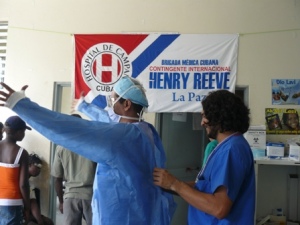
Following the quick, successful surgery, Dr Valverde tells me: “Working with the international teams here is a great learning experience. I can bounce ideas off the surgeons and they explain their techniques.” Heading back to the ER, Dr Valverde has a near skip in his step. “I love waking up and going to work in the morning.”
We’re met by a boy needing many stitches, including a severed vein that needs sewing, and Dr Valverde sets to work. Night is already falling, but the patients keep coming. “Another one?!” he asks when a young boy hops into the ER. But it’s his young patient from earlier with the infected wound, returning for his second antibiotic shot. The young surgeon compliments the boy for coming back as he finishes mending the vein of his current patient. “This was my most satisfying work in Haiti to date.”
